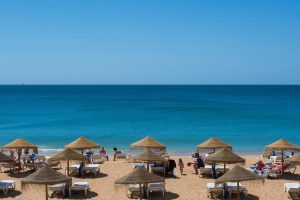There are few cities like Valencia, able to harmoniously combine the remnants of its farthest past, dating to the year 138 BC, with the most innovative and avant-garde buildings from the new millennium. Valencia is trade and culture, cinema, theatre, museums, magic, business.
It is the centre of international and avant-garde design, and one of the most active cities in Europe regarding fairs and conferences. Thanks to its location, Valencia has historically been Spain’s Mediterranean port and has that special charm of cities that are also seaports. And the fine sand and clean water, the vastness of the sea and the closeness of the coastal mountains make the Valencian coast uniquely attractive.
There are outstanding beaches and dunes at Canet d’En Berenguer, where the coastline becomes leisurely and residential, as it does to the north of the Valencian capital, where small tourist town (La Pobla de Farnals, Alboraya, and El Puig) have emerged where only a few years ago fruit and vegetables were grown.
In addition, still within the city of Valencia, the beaches of La Malvarrosa and Levante offer a wide variety of places to dine and enjoy a quiet evening by the sea.
To the south, nature becomes predominant at Saler Beach and in the L’Albufera Nature Reserve, where the sun can be enjoyed in unique surroundings.
The beaches of Cullera, Gandía and Oliva combine beautiful landscapes with a number of sporting and recreational facilities. Interesting routes await you inland, such as the one defined by the course of the Turia River, or charming towns like Buñol, Requena and Xátiva.
From the Roman forum to the Arts and Sciences Centre
When walking around Valencia, visitors can feel the pulse of many centuries in its walls and under the ground.
From the remains of the Roman forum founded by Junius Brutus and now in the Plaza de la Virgen which gave rise to Valencia, to the emblematic Arts and Sciences Centre, the city has transformed its appearance whilst rescuing monuments that are witness to past eras.
Valencia Cathedral is built in the same place where the first temple stood in the Roman times, and later on, a mosque. Because it was built between 1262 and 1426, and because of the extensions and renovations carried out later on, there are different styles superimposed on the predominant primitive Gothic.
The Miguelete Tower, the tower that is usually identified with Valencia outside, is the cathedral’s Gothic bell tower. It is 50.85 metres high, which is the same as its perimeter. It is a steep climb up the 207 steps, but worth it when you get to top and see the splendid views of the city.
In the same square, Plaza de la Virgen, there is also the Virgen de los Desamparados Basilica, and nearby, the Santo Domingo Convent, commissioned by the Dominicans in the 13th century, with the approval of by King Jaume I.
In Valencia’s historic quarter you can find other interesting churches, like Santa Catalina, San Nicolás and San Martín. Civil architecture is very important in the city. Two old gates to the city remain from the old medieval wall – Serranos and Quart towers.
The Palau de la Generalitat (Palace of the Autonomous Government) is a Gothic-style structure, built in the 15th century and later extended in the 17th and 20th centuries.
The building stands out because of its large Renaissance tower that leads to the Plaza de la Virgen. Yet beyond all doubt, the most remarkable building is the Lonja de la Seda (the Silk Exchange), an elegant Gothic structure built towards the end of the 15th century that has been declared World Heritage Site.
This ancient trading place holds authentic treasures in its interior, such as the monumental Salón de las Columnas, the Torreón Central and the Sala de Juntas del Consulado del Mar.
The City Hall, located in the city centre, occupies the old premises of the 18th century Real Casa de la Enseñanza. Modernism has also left a legacy in this city, with beautiful examples like the Central Market, made of iron, stained glass, and ceramic tiles; the Colón Market; and the magnificent Estación del Norte (North Railway Station). In addition to this huge architectural legacy, a myriad of museums grace the city.
One of the most symbolic is the Ciudad de las Artes y las Ciencias (City of the Arts and Sciences), a futuristic complex housing the L’Hemisfèric Cinema-Planetarium; the Palace of the Arts, devoted to promoting and publicising art; the Príncipe Felipe Science Museum; and the Universal Oceanographic Park. Valencia occupies one of the top places on the Spanish art scene, thanks to the Institute Valencian Institute of Modern Art (IVAM).
This centre has nine galleries that include permanent collections of the works of Julio González and Ignacio Pines, as well as other temporary exhibitions of painting, photography, and modern art, from the avant-garde movements of the early 20th century to the present. Located inside a Baroque building, the San Pío V Museum of Fine Arts is one of the most outstanding in Spain, thanks to its collection of the work of early Valencian artists; its collection includes Valencian school painters such as Hernando Yáñez de la Almedina, Juan de Juanes, the Ribaltas, Ribera, Espinosa, Vicente López, Sorolla, and Pinazo; and other artists of the stature of Pinturicchio, Andrea del Sarto, Van Dyck, Murillo, Velázquez, Bosch, El Greco, and Goya.
The museum also has sculptures by Mariano Benlliure, as well as interesting archaeological artefacts. Another remarkable art gallery is located in the complex of the Corpus Christi Seminary.
The Patriarch’s Museum has a 16th and 17th century painting collection, as well as works by Juan de Juanes, El Greco, and early Flemish painters. The church preserves Ribalta’s “Last Supper” at the high altar, as well as a Flemish tapestry in the Communion Chapel. The González Martí National Ceramics and Sumptuary Arts Museum is located in the Palace of Marqués de Dos Aguas, built in the 15th century, and refurbished in the 18th century.
The interior displays a vast collection of ceramics from Manises, Paterna, and Alcora, some of which date back to Christian times. Just as remarkable are the ancient pottery collection; the “socarrat” ceramic collection; the Chinese and Japanese pieces; and the pieces signed by figures like Picasso.
The festive nature of the people of Valencia is represented in two museums: the Museum of the Fallas keeps the “ninots” (papier mâché figures) which have been spared from burning in the annual Valencia fire festival for every years since 1934, and other elements that illustrate the history of the Fallas; and the Falla Artist Museum, where sketches, posters, photographs, and more spared “ninots” on display.
Do not forget the City Museum, or the Municipal History Museum, or the homes of famous personalities such as Vicente Blasco Ibáñez and José Benlliure.










